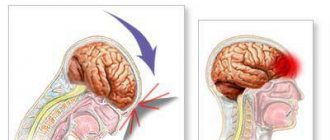Treatment of the disease
Treatment of torsion dystonia is conservative and surgical.
- Surgery:
- Stereotactic operations are indicated in cases where the disease rapidly progresses and deprives the patient of the ability to work and the ability to self-care. Stereotactic operations are aimed at destroying brain structures and are responsible for pathological impulses. Preparation for such an operation takes place in several stages. First, a special stereotactic frame is attached to the patient's head. A magnetic resonance or computed tomography scan of the brain is performed. Then, using special calculations using a tomogram and stereotaxic landmarks, the coordinates of the target structure are calculated. The surgeon accesses the required part of the brain and destroys the required structures in various ways. The duration of the disease and its severe course in the later stages are not contraindications to surgical intervention. After stereotactic operations, hyperkinesis and muscle rigidity in most cases decrease or disappear;
- it is possible to perform surgical interventions on peripheral nerves (neurotomy, radiotomy) for local forms of torsion dystonia. At the same time, their pathological effect on muscle groups is eliminated;
- in the later stages of torsion dystonia with joint deformities and muscle contractures, orthopedic operations are sometimes performed, so patients may also need the help of an orthopedic surgeon to correct pathological processes in the joints.
- Electrical stimulation of subcortical structures is the latest technique, which consists in the fact that electrodes producing electrical discharges are implanted into the area responsible for pathological impulses. These impulses suppress the activity of the pathological area of the brain. The operation is also performed using stereotactic guidance. After determining the coordinates of the target structure, the surgeon performs surgical access under intraoperative X-ray control and installs electrodes in certain subcortical nuclei. The neurostimulator itself, which produces electrical impulses, is a small device that is implanted into the subcutaneous fatty tissue of the subclavian region. After surgery, high-frequency electrical impulses are constantly sent to the patient's brain. In addition, the patient can adjust the parameters of the neurostimulator depending on his state of health.
- Drug therapy consists of prescribing certain groups of medications:
- anticholinergics;
- benzodiazepines;
- neuroleptics;
- anticonvulsants;
- muscle relaxants;
- Botox injections;
- GABAergic drugs;
- tranquilizers;
- glucocorticoids;
- adrenergic blockers;
- B vitamins.
Local forms of torsion dystonia (spasm of the hand, torticollis, adducted feet) are treated with botulinum toxin. It blocks the transmission of nerve impulses in those muscles in which spasm occurs.
Therapeutic gymnastics - anaerobic physical activity has a positive effect on the course of torsion dystonia. Hydrotherapy is also indicated.
Development of symptoms of torsion dystonia (clinical observation)
Torsion dystonia is a rare progressive disease of the central nervous system, occurring with a frequency of 3-4 cases per 100,000 population and having 13 genetic forms.
It is characterized by an uneven increase in muscle tone in certain parts of the body and the development of fixed pathological postures, most often in the legs, but sometimes in the arms, neck and torso. The course is relatively benign, but pathological postures are gradually accompanied by mild Parkinson-like symptoms: slowness of movements, “dystonic”
Below is a brief description of the patient's follow-up observation, illustrating the complexity of diagnosing torsion dystonia. Noteworthy is the severity of the clinical manifestations (photos of the patient at different years of life) with an absolutely normal picture on MR images.
Patient L. was systematically hospitalized in the department of psychoneurology and epilepsy of the Russian Children's Clinical Hospital for 10 years (from 4 years 4 months to 15 years). Diagnosis on initial admission: neuroinfection (encephalomyelopolyradiculoneuritis). Final diagnosis: torsion dystonia, dopa-independent, generalized form, progressive course.
From the anamnesis it is known that the girl was born from the 5th pregnancy (the mother had 2 term births), which occurred against the background of OPG-preeclampsia. At birth, the body weight was 2 kg 900 g, height 51 cm, head circumference 35 cm. From birth she was under the supervision of a neurologist for muscular dystonia syndrome and hand tremor. Early development corresponded to age norms. At the age of 4.5 years, a girl, 2 days after suffering from acute respiratory viral infection, developed a paraparetic type of gait disturbance. Weakness in the legs progressed, and at 4 years 7 months. the girl stopped walking on her own.
The clinical picture of examination and treatment is presented in chronological order.
At 4 years 7 months. In the neurological status, muscular hypotonia in the legs, torpid tendon reflexes, support on the forefoot, instability in the Romberg position, and severe autonomic symptoms (marbling of the skin, cold wet feet and palms) were noted. I could walk 5-6 steps on my own.
Examined:
- X-ray of the spine – no changes;
- the fundus is normal;
- EMG of the lower extremities: signs of denervation changes with an emphasis on the right. Electrogenesis of the muscles of the lower extremities with signs of suprasegmental influences;
- MRI of the spinal cord: in the lumen of the dural sac at the T5-T8 level, single hypointense focal formations of irregular shape measuring 5-7 mm, adjacent to the posterior surface of the spinal cord, are determined.
Diagnosis: myelopolyradiculoneuritis.
Prednisone therapy was carried out, during which the patient began to walk independently again (with a paraparetic gait, periodically complaining of weakness in the legs), quickly tired, and could not run. After a sore throat, the condition worsened again.
At the age of 5 years 3 months. the girl was examined by specialists at the 1st MMA clinic named after. I.M. Sechenov, diagnosed with antiphospholipid syndrome. At the Rheumatology Research Institute, systemic connective tissue diseases were excluded.
In the neurological status at this age, extrapyramidal syndrome first appeared (increased muscle tone of a plastic type, stiffness in the lower extremities).
Examined:
- ENMG: suprasegmental disorders, predominantly extrapyramidal in nature;
- EEG: diffuse cerebral changes in bioelectrical activity;
- Ophthalmologist: the fundus is normal;
- Genetic consultation: there is no evidence of hereditary pathology;
- MRI of the brain and spinal cord - no focal changes were detected. No lesions previously identified on MRI of the spinal cord were also found.
At 5 years 7 months. In the neurological status, the following were noted: lower paraparesis, increased muscle tone of the mixed cortical-subcortical type, high tendon reflexes, foot clonus.
Diagnosis: antiphospholipid syndrome. Subcortical syndrome.
Examined:
- ENMG: suprasegmental disorders, denervation changes at the C1-C4 level;
- Oculist: the fundus is unchanged;
- Endocrinologist: subclinical hypothyroidism.
She received metypred, mydocalm, nacom (1/4 t. x 2 times a day), l-thyroxine. During Nakom therapy, a temporary slight improvement was noted - a decrease in hypertonicity, increased movements in the lower extremities. After 2 months from the start of nacom therapy, clinical symptoms returned to baseline.
At the age of 6 years, dysarthria appeared in the neurological status, muscle tone was increased of a mixed type, tendon reflexes were high regardless of the sides, pathological symptoms on both sides. Slight tremor of the fingers of outstretched arms. Light intention when performing the finger-nose test. Doesn't walk independently.
Diagnosis: subacute sclerosing panencephalitis.
Examined:
- ENMG: suprasegmental disorders;
- Oculist: fundus without pathology;
- Myelography: spinal cord space-occupying process excluded;
- CT scan of the brain: no changes.
Received treatment: mydocalm, nacom.
At 6 years 4 months. Diagnosis: disseminated encephalomyelopolyradiculoneuritis, clinical symptoms the same.
At 7 years 7 months. the condition has worsened: muscle tone is increased according to the extrapyramidal type, more on the left. Speech has changed - quiet, slow, the patient is hypomimic. A tremor of the tongue appeared, and the tremor of the fingers intensified. Hyperkinesis was noted in the legs.
Diagnosis: lower spastic paraplegia (Strumpel's disease) with extrapyramidal disorders.
I received nootropil, cerebrolysin, nacom, mydocalm. An attempt to administer finlepsin led to increased hyperkinesis in the legs.
At 11 years old, in a neurological status: does not walk independently, tetraparesis, increased tone of a mixed type with a predominance of extrapyramidal. Quiet, slow speech. Tremor of the trunk, left-sided hemiballismus, torsion dystonia in the muscles of the trunk, torticollis. Hyperkinesis intensifies with movement and is combined with pathological synkinesis. Hypomimic.
Diagnosis: degenerative disease of the central nervous system, unclassified form. Hypothyroidism.
Examined: MRI of the brain - no changes.
When examined at the age of 12, it was noted that the condition was severe: he did not walk independently, could not get out of bed, only sat with support for a short time. Movement in the hands is impaired - cannot grasp objects, feeds with outside help. Most of the time he reads books, the pages of which he turns with his tongue. Tetraparesis, increased tone of the extrapyramidal type. Speech is dysarthric. Trunk tremor, left-sided hemiballismus, severe torsion dystonia of the limbs, torticollis. Hyperkinesis intensifies with movement. The diagnosis is suspected: torsion dystonia, dopa-independent form.
Follow-up observation. From the moment this diagnosis was made to the present (17 years old), the girl’s condition has been slowly deteriorating: torsion deformities and muscle rigidity are increasing. Repeated genetic analysis for DYT1 (dystonia type 1) did not reveal mutations; analysis for the other 12 forms was not carried out. Wilson-Konovalov disease (ceruloplasmin, copper is normal) and rheumatism were repeatedly excluded. During the course of the disease, no symptoms were noted that would refute the diagnosis of torsion dystonia.
Discussion:
The clinical picture of primary dystonia consists of gait disturbance, limb dystonia, lordosis or scoliosis, and postural tremor. Sometimes with primary dystonia, signs of parkinsonism are observed: bradykinesia, rest tremor, hypomimia, cogwheel symptom, night myoclonus. It should be noted that no matter how severe the motor disorders, the patients’ intelligence never suffers. On the contrary, their mental sphere is characterized by wit and observation, combined with a pessimistic mood.
Torsion dystonia is not characterized by morphological changes in the brain. The development of the disease is associated with disruption of neurotransmitter metabolism in the basal ganglia. Electrophysiological studies (electromyography) show that with dystonia, the central inhibition of reflex muscle tension under the influence of tactile stimuli is disrupted. The exact changes in neurochemistry in dystonia are unknown, but dopamine and its metabolites play a leading role.
It is difficult to diagnose torsion dystonia, since the diagnosis is based on clinical symptoms (dystonic postures and manifestations of parkinsonism) and the steadily progressive course of the disease. Unlike other genetic diseases, in this case there are no paraclinical diagnostic methods. A characteristic feature of torsion dystonia is an absolutely normal picture on neuroimaging, even in patients with severe clinical manifestations. Despite the fact that today all 13 genetic forms of the disease are known, in practice genetic analysis is carried out only for DYT1 - dystonia type 1. This form of the disease occurs in 20% of cases of torsion dystonia and is the most common.
Genetic tests for other forms are not yet carried out in the clinic due to technical complexity and high cost of reagents. Electromyography (EMG) reveals contractions of agonists and antagonists lasting more than 30 seconds, which end in a short period of quiescence; Repeated rhythmic contractions are also detected - 1-2 per second. - in the form of fast, irregular, short twitches and tremors of 6-10 Hz.
The diagnosis of torsion dystonia is largely based on the exclusion of other diseases that have a similar clinical picture. First of all, these are diseases of copper metabolism (Wilson-Konovalov disease), iron (Hallervorden-Spatz disease), etc.
Due to the genetic nature of the disease, etiotropic and pathogenetic treatment of torsion dystonia has not yet been developed. For symptomatic therapy, drugs that affect dopamine metabolism are used: dopamine agonists (carbidopa, levodopa); anticholinergics (trihexyphenidyl (Cyclodol), benztropine, procyclidine, ethopropazine), muscle relaxants (baclofen, clonazepam, tizanidine (Sirdalud), tolperisone (Mydocalm)), anticonvulsants (carbmazepine, gabapentin) and dopamine antagonists (neuroleptics). Drug therapy for torsion dystonia is complicated by side effects and a narrow therapeutic window. The use of botulinum toxin A injection into muscles is due to the interaction of botulinum toxin with acetylcholine receptors, which relax muscles. The method is indicated for focal dystonia, the effect is observed in approximately 50% of cases. The duration of action of botulinum toxin A is from 1 to 6 months, after which repeated administration is required. If medications are ineffective and symptoms progress slowly, neurosurgical treatment is performed, which consists of deep stimulation of the globus pallidus.
In recent years, research has been actively carried out on gene therapy for torsion dystonia in animal models. The positive results of these studies provide hope for patients.
Source: Medical Council magazine No. 3 2007.
Diagnosis of the disease
The diagnosis is made based on clinical data. Usually it is not in doubt if there are already cases in the family.
Methods of analysis and diagnostic tests indicated for this pathology:
- X-ray examination.
- Electromyography - allows you to identify disturbances in the activity of electrical potentials of muscles.
- Magnetic resonance imaging of the brain and spinal cord - to assess areas of damage.
- Electroneuromyography - allows you to evaluate the electrical activity of skeletal muscles and peripheral nerves.
- Electroencephalogram - helps to identify disturbances in the bioelectrical activity of the brain.
Differential diagnosis is carried out with torsion-dystonic syndromes, especially those caused by the chronic form of epidemic encephalitis and hepatocerebral dystrophy. Differential diagnostic significance for epidemic encephalitis is the acute development of the disease, sleep disturbance, diplopia, convergence insufficiency, gaze convulsions, autonomic disorders and, in later stages, symptoms of parkinsonism. Hepatocerebral dystrophy, in contrast to torsion dystonia, is characterized by a low level of ceruloplasmin in the blood, the presence of a Kayser-Fleischer ring (deposition of a greenish-brown pigment containing copper on the periphery of the cornea of the eyes), and cirrhosis of the liver.
Other diseases of the extrapyramidal system that occur with torsion-dystonic syndromes differ from torsion dystonia in that they do not progress and undergo reverse development (to varying degrees) with a decrease in the frequency and severity of hyperkinesis. In their clinical picture, along with hyperkinesis, there are other symptoms of brain damage that are not observed with torsion dystonia.
Etiology of the disease
Depending on the cause of its occurrence, the pathology has two forms:
- idiopathic torsion dystonia (familial);
- symptomatic dystonia.
In the first case, it is a hereditary disease. It is most often transmitted in an autosomal dominant manner, but recessive and X-linked forms are also found. Usually, in this case, one of the closest relatives already has a similar pathology.
Symptomatic dystonia appears against the background of other diseases, which result in damage to brain structures. These include:
- brain tumors;
- traumatic brain injuries;
- Huntington's chorea;
- cerebral palsy;
- tick-borne encephalitis;
- poisoning (including alcohol);
- parasitic diseases (giardiasis, toxoplasmosis);
- birth injuries.
Prices
| Disease | Approximate price, $ |
| Prices for diagnosing migraine | 7 060 — 8 260 |
| Prices for diagnosing childhood epilepsy | 3 100 — 4 900 |
| Prices for brain shunting for hydrocephalus | 33 180 |
| Prices for treatment of Parkinson's disease | 58 600 |
| Prices for migraine treatment | 9 680 |
| Prices for the diagnosis of amyotrophic lateral sclerosis | 6 550 |
| Prices for diagnosing epilepsy | 3 520 |
| Prices for rehabilitation after a stroke | 78 300 — 82 170 |
| Prices for treatment of childhood epilepsy | 3 750 — 5 450 |
| Prices for treatment of multiple sclerosis | 4 990 — 17 300 |










